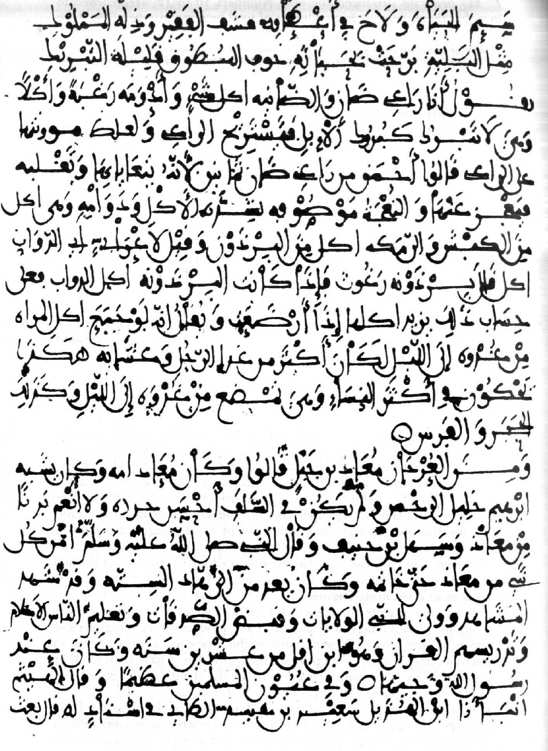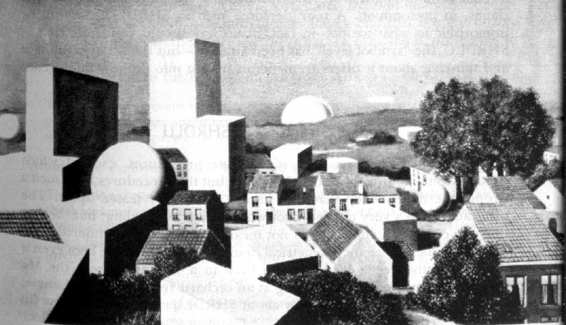Gödel, Escher, Bach: An Eternal Golden Braid (113 page)
Read Gödel, Escher, Bach: An Eternal Golden Braid Online
Authors: Douglas R. Hofstadter
Tags: #Computers, #Art, #Classical, #Symmetry, #Bach; Johann Sebastian, #Individual Artists, #Science, #Science & Technology, #Philosophy, #General, #Metamathematics, #Intelligence (AI) & Semantics, #G'odel; Kurt, #Music, #Logic, #Biography & Autobiography, #Mathematics, #Genres & Styles, #Artificial Intelligence, #Escher; M. C

The human-written sentences are numbers 1 to 3; they were drawn from the contemporary journal Art-Language15 and are-as far as I can tellcompletely serious efforts among literate and sane people to communicate something to each other. That they appear here out of context is not too misleading, since their proper context sounds just the same as they do.
My program produced the rest. Numbers 10 to 12 were chosen to show that there were occasional bursts of total lucidity; numbers 7 to 9 are more typical of the output, floating, in that curious and provocative netherworld between meaning and no-meaning; and then numbers 4 to 6 pretty much transcend meaning. In a generous mood, one could say that they stand on their own as pure "language objects", something like pieces of abstract sculpture carved out of words instead of stone; alternatively, one could say that they are pure pseudointellectual drivel.
My choice of vocabulary was still aimed at producing humorous effects. The flavor of the output is hard to characterize. Although much of it "makes sense", at least on a single-sentence level, one definitely gets the feeling that the output is coming from a source with no understanding of what it is saying and no reason to say it. In particular, one senses an utter lack of visual imagery behind the words. When I saw such sentences come pouring out of the line printer, I experienced complex emotions. I was very amused by the silliness of the output. I was also very proud of my achievement and tried to describe it to friends as similar to giving rules for building up meaningful stories in Arabic out of single strokes of the pen-an exaggeration, but it pleased me to think of it that way. And lastly I was deeply thrilled by the knowledge that this enormously complicated machine was shunting around long trains of symbols inside it according to rules, and that these long trains of symbols were something like thoughts in my own head
... something like them.
Images of What Thought Is
Of course I didn't fool myself into thinking that there was a conscious being behind those sentences-far from it. Of all people, I was the most aware of the reasons that this program was terribly remote from real thought. Tesler's Theorem is quite apt here: as soon as this level of language handling ability had been mechanized, it was clear that it did not constitute intelligence. But this strong experience left me with an image: a glimmering sense that
real
thought was composed of much longer, much more complicated trains of symbols in the brain-many trains moving simultaneously down many parallel and crisscrossing tracks, their cars being pushed and pulled, attached and detached, switched from track to track by a myriad neural shunting-engines ...
It was an intangible image which I cannot convey in words, and it was only an image. But images and intuitions and motivations lie mingled close in the mind, and my utter fascination with this image was a constant spur to think more deeply about what thought really could be. I have tried in other parts of this book to communicate some of the daughter images of this original image-particularly in the
Prelude, Ant Fugue
.
What stands out in my mind now, as I look back at this program from the perspective of a dozen years, is how there is no sense of imagery behind what is being said. The program had no idea what a serf is, what a person is, or what anything at all is.
The words were empty formal symbols, as empty

FIGURE 116.
A meaningful story in Arabic. [From A. Khatibi and M. S~elmassi, The
Splendour of Islamic Calligraphy (New York: Rizzoli, 1976).
as-perhaps emptier than-the p and q of the pq-system. My program took advantage of the fact that when people read text, they quite naturally tend to imbue each word with its full flavor-as if that were necessarily attached to the group of letters which form the word.
My program could be looked at as a formal system, whose "theorems"-the output sentences-had ready-made interpretations (at least to speakers of English). But unlike the pq-system, these "theorems" were not all true statements when interpreted that way.
Many were false, many were nonsense.
In its humble way, the pq-system mirrored a tiny corner of the world. But when my program ran, there was no mirror inside it of how the world works, except for the small semantic constraints which it had to follow. To create such a mirror of understanding, I would have had to wrap each concept in layers and layers of knowledge about the world. To do this would have been another kind of effort from what I had intended to do. Not that I didn't often think of trying to do it-but I never got around to trying it out.
Higher-Level Grammars ...
In fact, I often pondered whether I could write an
ATN
-grammar (or some other kind of sentence-producing program) which would only produce true sentences about the world.
Such a grammar would imbue the words with genuine meanings, in the way it happened in the pq-system and in
TNT
. This idea of a language in which false statements are ungrammatical is an old one, going back to Johann Amos Comenius, in 1633. It is very appealing because you have a crystal ball embodied in your grammar: just write down the statement you want to know about, and check to see if it is grammatical... . Actually, Comenius went even further, for in his language, false statements were not only ungrammatical-they were inexpressible!
Carrying this thought in another direction, you might imagine a highlevel grammar which would produce random koans. Why not? Such a grammar would be equivalent to a formal system whose theorems are koans. And if you had such a program, could you not arrange it to produce only genuine koans? My friend Marsha Meredith was enthusastic about this idea of "Artificial Ism", so she tackled the project of writing a koan-writing program. One of her early efforts produced this curious quasi-koan: A SMALL YOUNG MASTER WANTED A SMALL WHITE GNARLED
BOWL. "HOW CAN WE LEARN AND UNDERSTAND WITHOUT STUDY"
THE YOUNG MASTER ASKED A LARGE CONFUSED MASTER. THE
CONFUSED MASTER WALKED FROM A BROWN HARD MOUNTAIN TO A
WHITE SOFT MOUNTAIN WITH A SMALL RED STONY BOWL. THE
CONFUSED MASTER SAW A RED SOFT HUT.THE CONFUSED MASTER
WANTED THE HUT. "WHY DID BODHIDHARMA COME INTO CHINA?"
THE CONFUSED MASTER
ASKED A LARGE ENLIGHTENED STUDENT. "THE PEACHES ARE
LARGE", THE STUDENT ANSWERED THE CONFUSED MASTER.w "HOW
CAN WE LEARN AND UNDERSTAND WITHOUT STUDY?" THE
CONFUSED MASTER ASKED A LARGE OLD MASTER. THE OLD MASTER
WALKED FROM A WHITE STONY G0025. THE OLD MASTER GOT LOST.
Your personal decision procedure for koan genuineness probably reached a verdict without need of the Geometric Code or the Art of Zen Strings. If the lack of pronouns or the unsophisticated syntax didn't arouse your suspicions, that strange
"00025" towards the end must have. What is it? It is a strange fluke-a manifestation of a bug which caused the program to print out, in place of the English word for an object, the program's internal name for the "node" (a
LISP
atom, in fact) where all information concerning that particular object was stored. So here we have a "window" onto a lower level of the underlying Zen mind-a level that should have remained invisible.
Unfortunately, we don't have such clear windows onto the lower levels of human Zen minds.
The sequence of actions, though a little arbitrary, comes from a recursive
LISP
procedure called "
CASCADE
", which creates chains of actions linked in a vaguely causal way to each other. Although the degree of comprehension of the world possessed by this koan generator is clearly not stupendous, work is in progress to make its output a little more genuine seeming.
Grammars for Music?
Then there is music. This is a domain which you might suppose, on first thought, would lend itself admirably to being codified in an
ATN
grammar, or some such program.
Whereas (to continue this naive line of thought) language relies on connections with the outside world for meaning, music is purely formal. There is no reference to things "out there" in the sounds of music; there is just pure syntax-note following note, chord following chord, measure following measure, phrase following phrase...
But wait. Something is wrong in this analysis. Why is some music so much deeper and more beautiful than other music? It is because form, in music, is expressive-expressive to some strange subconscious regions of our minds. The sounds of music do not refer to serfs or city-states, but they do trigger clouds of emotion in our innermost selves; in that sense musical meaning is dependent on intangible links from the symbols to things in the world-those "things", in this case, being secret software structures in our minds. No, great music will not come out of such an easy formalism as an
ATN
-
grammar. Pseudomusic, like pseudo-fairy tales, may well come out-and that will be a valuable exploration for people to make-but the secrets of meaning in music lie far, far deeper than pure syntax.
I should clarify one point here: in principle, ATN-grammars have all the power of any programming formalism, so if musical meaning is captur-

able in any way at all (which I believe it is), it is capturable in an A I N - grammar. True.
But in that case, I maintain, the grammar will be defining not just musical structures, but the entire structures of the mind of a beholder. The "grammar" will be a full grammar of thought-not just a grammar of music.
Winograd's Program SHRDLU
What kind of program would it take to make human beings admit that it had some
"understanding", even if begrudgingly? What would it take before you wouldn't feel intuitively that there is "nothing there"?
In the years 1968-70, Terry Winograd (alias Dr. Tony Earrwig) was a doctoral student at
MIT
, working on the joint problems of language and understanding. At that time at
MIT
, much Al research involved the so-called
blocks world
-a relatively simple domain in which problems concerning both vision and language-handling by computer could fit easily. The blocks world consists of a table with various kinds of toy-like blocks on it-square ones, oblong ones, triangular ones, etc., in various colors. (For a "blocks world" of another kind, see Figure 117: the painting
Mental Arithmetic
by Magritte. I find its title singularly appropriate in this context.) The vision problems in the
MIT
blocks world are very tricky: how can a computer figure out, from a TV-scan of a scene with many blocks in it, just what kinds of blocks are present, and what their relationships are?
Some blocks may be perched on top of others, some may be in front of others, there may be shadows, and so on.
FIGURE 117.
Mental Arithmetic, by Rene Magritte (1931).
Winograd s work was separate from the issues of vision, however. Beginning with the assumption that the blocks world was well represented h inside the computer's memory, he confronted the many-faceted problem of how to get the computer to: (1) understand questions in English about the situation;
(2) give answers in English to questions about the situation;
(3) understand requests in English to manipulate the blocks;
(4) break down each request into a sequence of operations it could do; (5) understand what it had done, and for what reasons;
